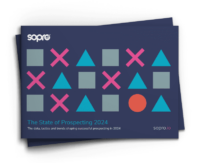What is a sales cadence and why on earth do you need one?

In the simplest of terms, you can define a sales cadence as a sales follow-up plan. That is, the actions taken to ‘chase’ a prospect.
Increasingly, prospects need to hear from you several times before they respond, let alone make a purchase.
The bottom line is this: a lack of response does not necessarily mean a lack of interest.
- Prospects will receive hundreds of emails each day, and yours may have got lost toward the bottom of their inbox.
- Or, perhaps they have actually read your email but not had the opportunity to respond yet.
- Or, maybe, your solution didn’t quite match their responsibilities and they were intending to forward it to a colleague but never got around to it.
Without following up, you will never know.
But how best to follow up?
The optimising of this process across many touchpoints or channels is when a sales cadence becomes a beautifully orchestrated thing.
So, what is a sales cadence?
Sacrificing simplicity for accuracy we can offer this definition.
A sales cadence is a sequence of touchpoints with a prospect that tries to establish a connection for an engagement or a sale.
It is typically expressed as a schedule that sales and marketing teams work together to coordinate across a number of channels (such as email, phone, social media, direct mail and so on).
How do you know a sales cadence has started (and when can you say it has ended)?
A sales cadence starts at the first point of contact.
It continues through the planned sequence of interactions until the prospect is either converted into a sales opportunity or leaves the cadence (usually to be entered into a lead nurturing programme).
Why is a sales cadence needed?
A sales cadence is to B2B prospecting what multichannel marketing is to ecommerce.
By diversifying your outreach across multiple channels, you will find some prospects who are more receptive over the phone than others and some who prefer social media.
More than this, however, time and time again we see that a sales cadence is perceived as less intrusive than continuing to hit the same channel every time and that different channels will help to reinforce the strength of your message – and its credibility.
A defined sales cadence offers a structured framework that eliminates guesswork and maintains consistency between your interaction with identified prospects. It also creates a deliberately compressed way to close deals by following up regularly in a short space of time.
In many ways, by combining a sales cadence with your outbound sales strategy you are in effect adding in a way to boost your conversion rates.

The State of Prospecting 2024
An in-depth look at the tactics and trends shaping successful B2B prospecting in 2024.
Download itHow can you build a sales cadence?
Building a sales cadence is like painting the proverbial Forth bridge. As soon as you think you are finished you need to start all over again.
Your sales cadence can not only be optimised over time but it is also not a one-size-fits-all solution. It will differ depending on factors like the target market, buyer persona, region, product/service, seasonality and so on.
Keep testing, keep monitoring and keep the cadence ringing.
Here are some of the buttons your sales cadence will need to press.
- The audience
You need to be clear about what your target audience’s pain points are and which aspects of your solution appeal most to them.
- The channels
The best sales cadence will include a combination of channels. These may be email, phone calls, voicemail, text messages, social media, video or direct mail. Choose the channels that most appeal to – or elicit a response from – your prospects.
- The sequencing
How you sequence your touchpoints needs careful consideration, as does the number of contact attempts in total. Sometimes it can be effective to use two touchpoints almost simultaneously, such as leaving a voicemail and emailing to explain what the call was about.
- The spacing
Unless there is strategic value in contacting someone more than once a day, the rule of thumb is to space contact attempts by at least a day, if not two.
- The duration
This is largely determined by the number of contact attempts and the spacing between them. As a rough idea, it is usual to aim for a duration of between a fortnight and a month.
Duration is the length of the sales cadence—from the first touch point to the last. The ideal duration of your sales cadence should be about two to four weeks. This, of course, depends on the prospect’s engagement with your email and phone call.
- The segments
Any factor that may require a different sales cadence to be used should be identified and your target audience should be segmented accordingly.
You may use considerations of region, sector, company size, seniority or job function to do this.
- The content
Assuming you had all of the above absolutely spot on, it would not necessarily mean the deals would come flying in. The chances of your prospect responding positively will very much depend on the quality of your outreach approach.
Over to you
Hopefully, we’ve told you enough to want to know more.
If not, don’t worry: we’ll be following up on social, by email, leaving voicemail messages and even dropping off a personalised video message.
Sales cadences are there to ensure that things don’t fall through the cracks and that you keep everyone moving across stages in your sales funnel.
To discover how Sopro can take your email outreach to the next level as part of your sales cadence, watch the video below or get in touch.







Share